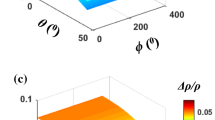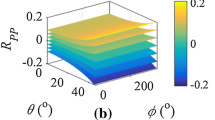Abstract
Seismic amplitude variation with offset and azimuth (AVOaz) inversion is well known as a popular and pragmatic tool utilized to estimate fracture parameters. A single set of vertical fractures aligned along a preferred horizontal direction embedded in a horizontally layered medium can be considered as an effective long-wavelength orthorhombic medium. Estimation of Thomsen’s weak-anisotropy (WA) parameters and fracture weaknesses plays an important role in characterizing the orthorhombic anisotropy in a weakly anisotropic medium. Our goal is to demonstrate an orthorhombic anisotropic AVOaz inversion approach to describe the orthorhombic anisotropy utilizing the observable wide-azimuth seismic reflection data in a fractured reservoir with the assumption of orthorhombic symmetry. Combining Thomsen’s WA theory and linear-slip model, we first derive a perturbation in stiffness matrix of a weakly anisotropic medium with orthorhombic symmetry under the assumption of small WA parameters and fracture weaknesses. Using the perturbation matrix and scattering function, we then derive an expression for linearized PP-wave reflection coefficient in terms of P- and S-wave moduli, density, Thomsen’s WA parameters, and fracture weaknesses in such an orthorhombic medium, which avoids the complicated nonlinear relationship between the orthorhombic anisotropy and azimuthal seismic reflection data. Incorporating azimuthal seismic data and Bayesian inversion theory, the maximum a posteriori solutions of Thomsen’s WA parameters and fracture weaknesses in a weakly anisotropic medium with orthorhombic symmetry are reasonably estimated with the constraints of Cauchy a priori probability distribution and smooth initial models of model parameters to enhance the inversion resolution and the nonlinear iteratively reweighted least squares strategy. The synthetic examples containing a moderate noise demonstrate the feasibility of the derived orthorhombic anisotropic AVOaz inversion method, and the real data illustrate the inversion stabilities of orthorhombic anisotropy in a fractured reservoir.















Similar content being viewed by others
References
Bachrach R (2015) Uncertainty and nonuniqueness in linearized AVAZ for orthorhombic media. Lead Edge 34:1048–1056
Backus GE (1962) Long-wave elastic anisotropy produced by horizontal layering. Geophysics 67:4427–4440
Bakulin A, Grechka V, Tsvankin I (2000) Estimation of fracture parameters from reflection seismic data—part II: fractured models with orthorhombic symmetry. Geophysics 65:1803–1817
Bakulin A, Grechka V, Tsvankin I (2002) Seismic inversion for the parameters of two orthogonal fractures sets in a VTI background medium. Geophysics 67:292–299
Chen H, Zhang G, Ji Y, Yin X (2017) Azimuthal seismic amplitude difference inversion for fracture weakness. Pure appl Geophys 174:279–291
Downton J (2005) Seismic parameter estimation from AVO inversion. Ph.D. Thesis, University of Calgary
Downton JE, Roure B (2015) Interpreting azimuthal Fourier coefficients for anisotropic and fracture parameters. Interpretation 3:ST9–ST27
Hampson DP, Russell BH, Bankhead B (2005) Simultaneous inversion of pre-stack seismic data. In: SEG technical program expanded abstracts, pp 1633–1637
Hill R (1952) The elastic behavior of crystalline aggregate. Proc Phys Soc 65:349–354
Hornby BE, Schwartz LM, Hudson JA (1994) Anisotropic effective medium modeling of the elastic properties of shales. Geophysics 59:1570–1583
Hudson JA (1981) Wave speeds and attenuation of elastic waves in material containing cracks. Geophys J Int 64:133–150
Mallick S, Craft KL, Meister LJ, Chambers RE (1998) Determination of the principal directions of azimuthal anisotropy from P-wave seismic data. Geophysics 63:692–706
Pan X, Zhang G, Chen H, Yin X (2017a) McMC-based AVAZ direct inversion for fracture weaknesse. J Appl Geophys 138:50–61
Pan X, Zhang G, Chen H, Yin X (2017b) McMC-based nonlinear EIVAZ inversion driven by rock physics. J Geophys Eng 14:368–379
Pšenčik I, Martins JL (2001) Properties of weak contrast PP reflection/transmission coefficients for weakly anisotropic elastic media. Stud Geophys Geod 45:176–199
Pšenčik I, Vavryčuk V (1998) Weak contrast PP-wave displacement R/T coefficients in weakly anisotropic elastic media. Pure Appl Geophys 151:699–718
Rüger A (1997) P-wave reflection coefficients for transversely isotropic models with vertical and horizontal axis of symmetry. Geophysics 62:713–722
Rüger A (1998) Variation of P-wave reflectivity with offset and azimuth in anisotropic media. Geophysics 63:935–947
Sacchi MD, Ulrych TJ (1995) High-resolution velocity gathers and offset space reconstruction. Geophysics 60:1169–1177
Scales JA, Smith ML (1994) Introductory geophysical inverse theory. Samizdat Press
Schoenberg M, Douma J (1988) Elastic wave propagation in media with parallel fractures and aligned cracks. Geophys Prospect 36:571–590
Schoenberg M, Helbig K (1997) Orthorhombic media: modeling elastic wave behavior in a vertically fractured earth. Geophysics 62:1954–1957
Schoenberg M, Muir F (1989) A calculus for finely layered anisotropic media. Geophysics 54:581–589
Shaw RK, Sen MK (2004) Born integral, stationary phase and linearized reflection coefficients in weak anisotropic media. Geophys J Int 158:225–238
Shaw RK, Sen MK (2006) Use of AVOAZ data to estimate fluid indicator in a vertically fractured medium. Geophysics 71:C15–C24
Thomsen L (1986) Weak elastic anisotropy. Geophysics 51:1954–1966
Tsvankin L (1997) Anisotropic parameters and P-wave velocity for orthorhombic media. Geophysics 62:1292–1309
Zong Z, Yin X, Wu G (2012) AVO inversion and poroelasticity with P- and S-wave moduli. Geophysics 77:29–36
Acknowledgements
We would like to express our gratitude to the sponsorship of National Natural Science Foundation of China (41674130), National Basic Research Program of China (973 Program, 2014CB239201), National Grand Project for Science and Technology (2016ZX05027004-001, 2016ZX05002005-09HZ), and the Fundamental Research Funds for the Central Universities. We are very grateful to an anonymous associate, and Alexey Stovas for their constructive suggestions.
Author information
Authors and Affiliations
Corresponding author
Appendices
Appendix 1: Derivation for Linearized PP-Wave Reflection Coefficient in a Weakly Anisotropic Medium with Orthorhombic Symmetry Formed by a Single Set of Aligned Vertical Fractures Embedded in a VTI Background
The relationships between the subscripts (I, J) and (i, j, k, l) in Eq. (30) are given by Shaw and Sen (2006)
and
where \(\delta_{ij}\) and \(\delta_{kl}\) both denote the Kronecker delta.
For the case of P-wave incidence and reflection, the polarization and slowness vectors are given by
and
where α represents the background P-wave velocity, and \(\phi\) represents the azimuthal phase angle.
Substituting Eqs. (43) and (44) into Eq. (30), the expression of \(\xi\) is then given by
Substituting Eqs. (43)–(47) into Eq. (30), the expression of \(\eta_{IJ}\) is then given by
The calculation of Eq. (30) then yields
Combining Eq. (49), the calculation of Eq. (29) finally gives
Appendix 2: Derivation for Linearized PP-Wave Reflection Coefficients in a Weakly Anisotropic Medium with Orthorhombic Symmetry Formed by Two Orthogonal Vertical Fracture Sets Embedded in an Isotropic or VTI Background
Two orthogonal vertical fracture sets embedded in an isotropic or VTI background can be both considered as an effective long-wavelength orthorhombic medium (Bakulin et al. 2000, 2002). To further simplify the procedure of parameter estimation, the fracture sets are assumed to be rotationally invariant. For such a weakly anisotropic medium with orthorhombic symmetry formed by two orthogonal vertical fracture sets embedded in an isotropic background, where the first fracture set is perpendicular to the x axis (shown in Fig. 1b), neglecting the terms that contain \(\delta_{{{\text{N}}1}} \delta_{{{\text{N}}2}}\) and \(\delta_{{{\text{T}}1}} \delta_{{{\text{T}}2}}\) for the case of small fracture weaknesses, an expression for the effective elastic stiffness tensor can be approximated as
where 0 represents the 3 × 3 zero matrix, and \({{\hat{\mathbf{C}}}}_{1}\) and \({{\hat{\mathbf{C}}}}_{2}\) are given by
and
Here \(\delta_{{{\text{N}}i}} = {{Z_{{{\text{N}}i}} M} \mathord{\left/ {\vphantom {{Z_{{{\text{N}}i}} M} {\left[ {1 + Z_{{{\text{N}}i}} M} \right]}}} \right. \kern-0pt} {\left[ {1 + Z_{{{\text{N}}i}} M} \right]}}\) and \(\delta_{{{\text{T}}i}} = {{Z_{{{\text{T}}i}} \mu } \mathord{\left/ {\vphantom {{Z_{{{\text{T}}i}} \mu } {\left[ {1 + Z_{{{\text{T}}i}} \mu } \right]}}} \right. \kern-0pt} {\left[ {1 + Z_{{{\text{T}}i}} \mu } \right]}}\) represent the normal and tangential weaknesses of two orthogonal vertical fracture sets related to the corresponding normal and tangential fracture compliances Z Ni and Z Ti .
Following a similar derivation method for the case of small fracture weaknesses, the expression for linearized PP-wave reflection coefficient in such an orthorhombic medium can be expressed as
Similarly, for such an orthorhombic medium formed by two orthogonal vertical fracture sets embedded in a VTI background (shown in Fig. 1c), neglecting the terms that contain \(\varepsilon_{\text{b}} \delta_{{{\text{N}}1}}\), \(\varepsilon_{\text{b}} \delta_{{{\text{N}}2}}\), \(\varepsilon_{\text{b}} \delta_{{{\text{N}}1}} \delta_{{{\text{N}}2}}\), \(\gamma_{\text{b}} \delta_{{{\text{N}}1}}\), \(\gamma_{\text{b}} \delta_{{{\text{N}}2}}\), \(\gamma_{\text{b}} \delta_{{{\text{N}}1}} \delta_{{{\text{N}}2}}\),\(\delta_{\text{b}} \delta_{{{\text{N}}1}}\), \(\delta_{\text{b}} \delta_{{{\text{N}}2}}\), \(\delta_{\text{b}} \delta_{{{\text{N}}1}} \delta_{{{\text{N}}2}}\), \(\gamma_{\text{b}} \delta_{{{\text{T}}1}}\), \(\gamma_{\text{b}} \delta_{{{\text{T}}2}}\), and \(\gamma_{\text{b}} \delta_{{{\text{T}}1}} \delta_{{{\text{T}}2}}\) for the case of weak anisotropy and small fracture weaknesses, an expression for the effective elastic stiffness tensor can be approximated as
where 0 represents the 3 × 3 zero matrix, and \({\hat{\hat{\mathbf{C}}}}_{1}\) and \({\hat{\hat{\mathbf{C}}}}_{2}\) are given by
and
Following a similar derivation method for the case of weak anisotropy and small fracture weaknesses, the expression for linearized PP-wave reflection coefficient in such an orthorhombic medium can be expressed as
Rights and permissions
About this article
Cite this article
Pan, X., Zhang, G. & Yin, X. Azimuthal Seismic Amplitude Variation with Offset and Azimuth Inversion in Weakly Anisotropic Media with Orthorhombic Symmetry. Surv Geophys 39, 99–123 (2018). https://doi.org/10.1007/s10712-017-9434-2
Received:
Accepted:
Published:
Issue Date:
DOI: https://doi.org/10.1007/s10712-017-9434-2




